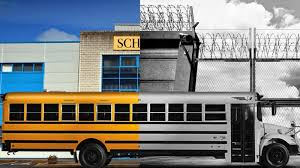Abstract
Excerpted From: Hailey Berry, The School to Prison Pipeline: How Public Schools Continuously Fail and Isolate Society's Most Vulnerable Children, 22 Seattle Journal for Social Justice 227 (Winter, 2024) (166 Footnotes) (Full Document)
 The school-to-prison pipeline “funnel[s] students out of public schools and into the juvenile and criminal legal systems” while disproportionately impacting students who are Black, have experienced poverty, or have disabilities. During the 2017-2018 school year, school-related arrests increased by 5% nationally, and referrals to law enforcement increased by 12% nationally. Black children account for 15% of the total enrollment of K-12 public schools yet make up 38.8% of expulsions with educational services and 33.3% of expulsions without educational services. Similarly, students with disabilities represent 16% of the total enrollment of K-12 public schools but make up nearly 30% of school arrests. Black students receiving services represent 2.3% of the student body but account for 9.1% of student arrests. Both students of color and students with disabilities are being over-disciplined and discriminated against across the country.
The school-to-prison pipeline “funnel[s] students out of public schools and into the juvenile and criminal legal systems” while disproportionately impacting students who are Black, have experienced poverty, or have disabilities. During the 2017-2018 school year, school-related arrests increased by 5% nationally, and referrals to law enforcement increased by 12% nationally. Black children account for 15% of the total enrollment of K-12 public schools yet make up 38.8% of expulsions with educational services and 33.3% of expulsions without educational services. Similarly, students with disabilities represent 16% of the total enrollment of K-12 public schools but make up nearly 30% of school arrests. Black students receiving services represent 2.3% of the student body but account for 9.1% of student arrests. Both students of color and students with disabilities are being over-disciplined and discriminated against across the country.
The combination of race and disability compounds these effects. For example, J.W., a Black high school student with emotional and intellectual disabilities, was unable to access the space that he used to calm down at school. Unable to find a safe space to escape from his bullies, J.W. attempted to leave campus by walking home. The school responded by blocking J.W. from exiting and calling the school police officer who tased and handcuffed J.W. Since this incident, J.W. has “missed several months of school while experiencing intense anxiety and PTSD.” The Fifth Circuit made a dangerous ruling when they decided that “the tasing of J.W. was an act of school discipline that couldn't be challenged under the Fourth Amendment.” This ruling opened the door to the use of harsh discipline and excessive force on students with disabilities, effectively stripping them of a safe school environment.
The harsh disciplinary practices and lack of resources for students with disabilities in public school systems disproportionately funnel certain groups of children into the juvenile justice system, which perpetuates systemic harm. Without reform of the current educational system, students with disabilities-- especially indigent Black students--will continue to be funneled through the school-to-prison pipeline in violation of their civil rights. The federal government must create a safety net for students with disabilities to disrupt their trajectory toward the juvenile justice system.
The federal government must require all public schools to provide free assessments for students who may have disabilities and mental health issues before schools can expel or send students into the juvenile justice system. The students should be assessed and, if they qualify for accommodations, be given time to receive the support they need before any disciplinary actions are taken against them. School systems should be required to offer assessments for accommodations as an alternative to disciplinary action against all K-12 students. This safety net would then inform the student and the school system of the necessary resources needed to support the student's needs. Regardless of the visibility of a student's disability, students still have the right to access the necessary resources they need to support their success.
To understand how this current educational system is failing students with disabilities, we must examine 1) federal education laws, 2) the ADA, 3) the evolution of discipline within the public education system, and 4) harm reduction methods. Although this article acknowledges the impacts that the school-to-prison pipeline has on students of color, the focus of this article will be on students with disabilities.
[. . .]
We cannot stop short of making systemic changes and redesigning the discipline within the public education system. Education is an invaluable tool that everyone has a right to. Education imparts academic knowledge and vital life skills, helping children navigate the world.
The federal government needs to immediately mitigate the harmful disciplinary and exclusionary practices widely used in public schools. Specifically, harm reduction measures that make disability accommodations accessible and which replace expulsion, suspension, and referral to alternative schools or law enforcement need to be implemented. Students with disabilities are currently being discriminated against and funneled into the school-to-prison pipeline, and these discriminatory actions have lifelong impacts on these children. Action must be taken because discrimination and harmful practices are used in the public school system daily.
While harm reduction measures provide some relief to students with disabilities, this cannot be the end of the conversation surrounding the improvement of the education system. There are numerous alternative methods of behavioral management and accommodations that would create a healthy and safe school environment. Lasting alternatives that result in long-term positive change must be developed as soon as possible because it is not sufficient to rely on harm reduction recommendations. Harm reduction methods are intended as a temporary reaction to a crisis of discrimination and segregation. It is crucial that the development of these alternatives involve the students and their families. A key tenant of Disability Rights Advocacy is “nothing about us without us” which highlights the need to “empower persons with disabilities to take control over decisions affecting their lives.” 6
No Info


